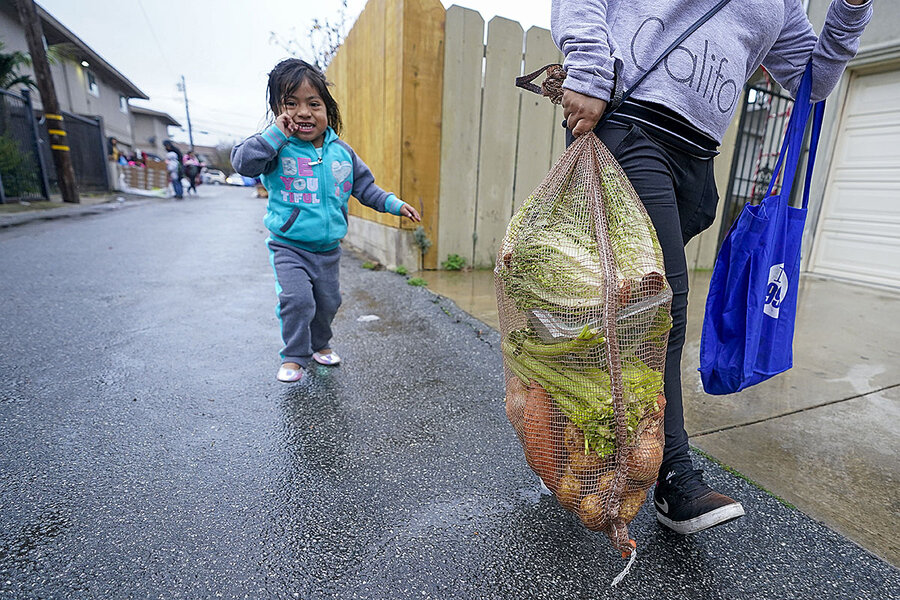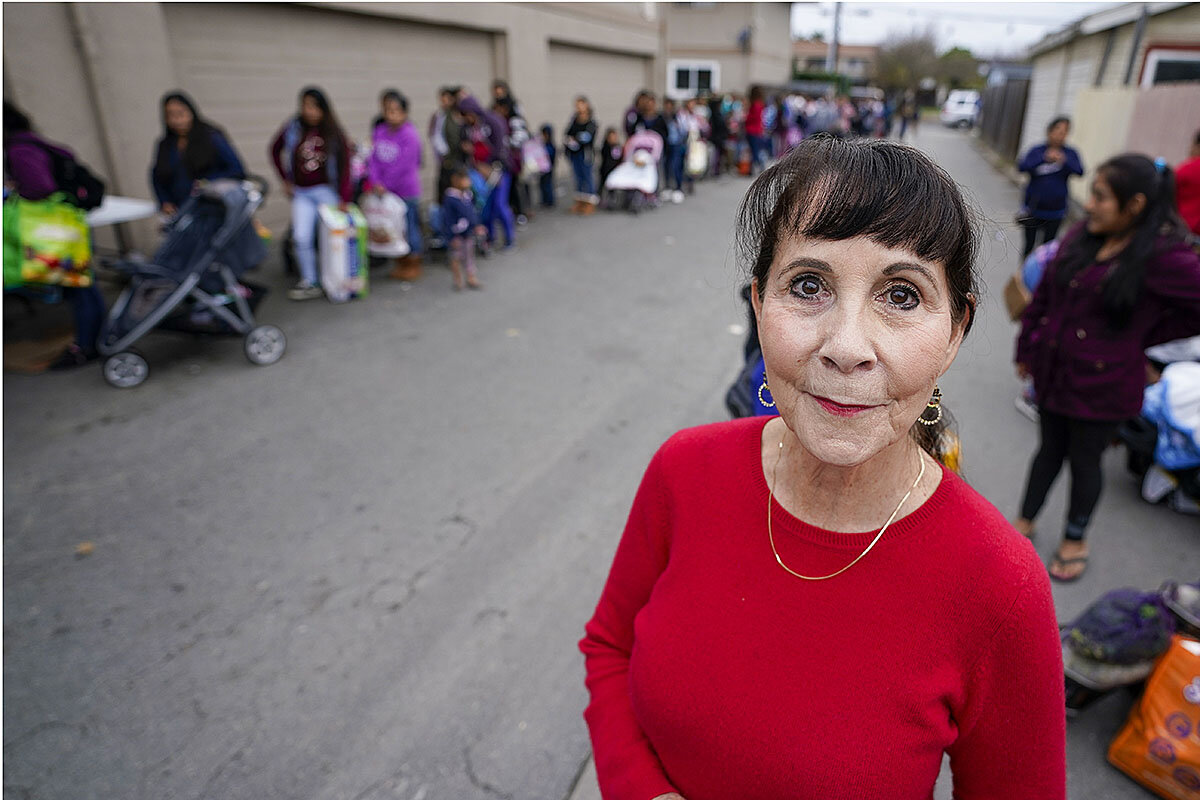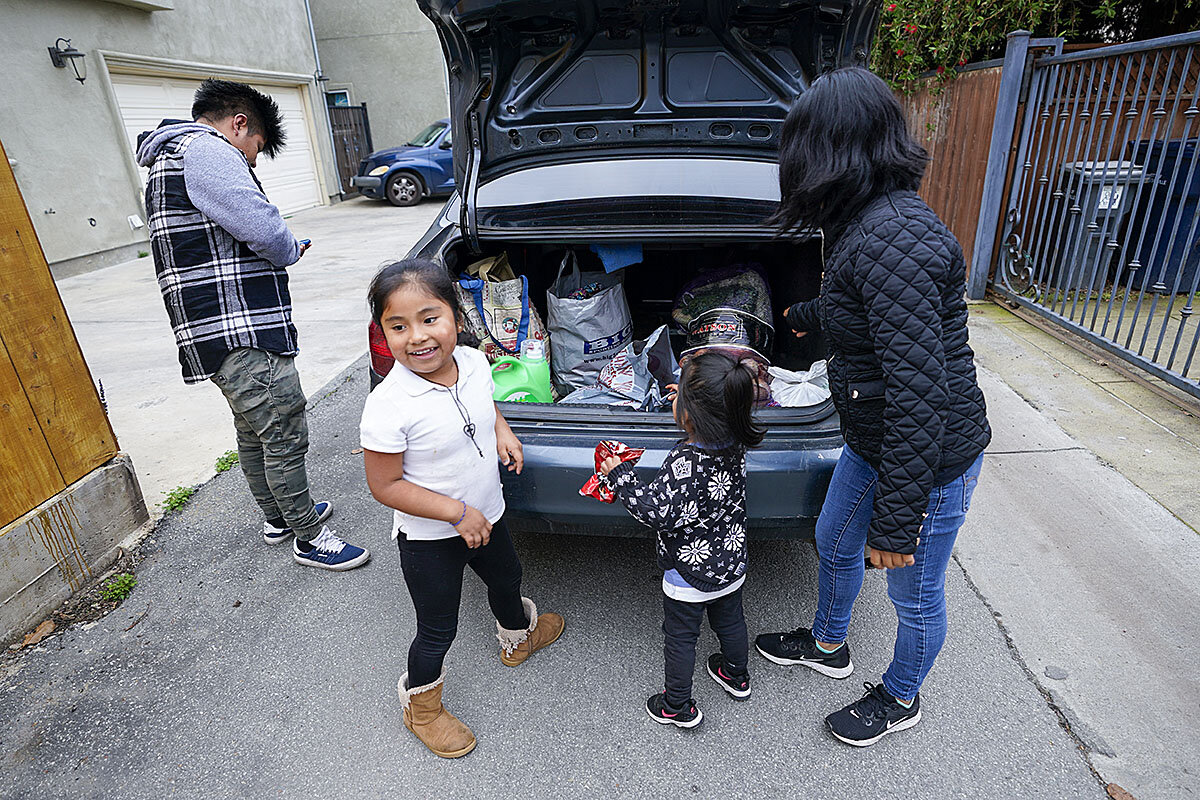Inside the secret food bank that keeps farmworkers from going hungry
Loading...
| Watsonville, Calif.
The early winter storms gathering in the Pacific bring welcome rains to California’s tinder-dry landscape. But for farmworkers picking strawberries for less than minimum wage, the rains signal the end of the harvest season and regular work, and deliver a downpour of hunger and worry.
That’s why about 170 indigenous Mexican women from Oaxaca line up for hours in an alley to obtain sacks of produce, diapers, and other essentials from a secret food bank once a month. For those who spend grueling days harvesting America’s bounty, this surreptitious pop-up – organized solely by word of mouth – provides a safe place for accessing free, nutritious food and supplies without fear of deportation by la migra, or U.S. Immigration and Customs Enforcement agents (ICE).
Once the self-proclaimed “Frozen Food Capital of the World,” this predominantly Latino agricultural city of 53,900 is located in Santa Cruz County, the least affordable county in the state for renters.
Why We Wrote This
What to do when you work with food all day, but can’t afford enough to eat? An underground food bank in California tries to help Latino farmworkers feed their families.
Though synonymous with beaches and surfer dudes, the county is home to some of the country’s most vulnerable – the thousands of indigenous farmworkers in California, an unknown number of unauthorized residents, who live in severely substandard conditions and speak a variety of pre-Columbian languages rather than English or Spanish.
The stealth food operation – not far from the canneries where striking workers rallied in the 1980s – is meant to take a bit of the edge off. It is organized by Ann López, in conjunction with the Second Harvest Food Bank of Santa Cruz County. An emerita professor, “Dr. Ann” as she is known, started a nonprofit called the Center for Farmworker Families after interviewing numerous agricultural laborers for her Ph.D. dissertation. “There was a family with four little girls crying for food,” she recalls. “I opened the refrigerator and they had a head of lettuce, one third of a gallon of milk, and two Jell-O cups. That was it. What I found was a population inordinately poor and suffering.”
The “devil’s fruit”
Ernestina Solorio, who has legal status to work in the U.S., spends 10 hours a day, six days a week in the fields during the season. Strawberries are among the most labor-intensive crops, known as la fruta del diablo, or the devil’s fruit, for the hours it takes hunched over low-to-the-ground berries to pluck them without bruising.
Ms. Solorio earns $20,000 in a good year, well above average for a farmworker but also well under the federal poverty rate for Ms. Solorio’s family of four children. Sky-high rents eat up roughly 75% to 80% of a farmworker’s income, and a typical scenario is paying $600 a month for a family to sleep in a living room, says Gretchen Regenhardt, regional directing attorney for California Rural Legal Assistance, which provides legal services for low-income communities.
The math is grim: about $200 a month after rent to pay for everything else. “The work won’t pick up again until mid-April, depending on the weather,” Ms. Solorio explains. “That’s why so many of us are stressed.”
From a makeshift staging area in a garage, her compatriots file past tables piled high with diapers, laundry detergent, and toilet tissue, all while juggling toddlers in pajamas and babies nestled in blankets or shawl rebozos (traditional baby carriers).
Some dig through piles of donated clothes before moving on to the main event – repurposed onion bags heavy with sweet potatoes, carrots, cabbage, kale, and other fresh vegetables and smaller white plastic bags filled with rice, lentils, and canned goods from the USDA. Strollers double as grocery carts. Those on foot weighed down by 30 pounds of goods teeter gingerly down the alleyway.
“You would never see this concentration of Oaxacans,” says Ms. López, dressed for the season in a bright red sweater and snowman earrings. “They are always hiding in the fields or their apartments.”
On edge, then a respite
Fears about ICE raids – such as the arrest of 680 people in agricultural processing plants in Mississippi this past August – ricochet through the community, as did the massacre at a Walmart in El Paso, Texas, that was fueled by anti-Hispanic and anti-immigrant zealotry.
The Trump administration’s proposed changes to federal immigration rules mean that people could be denied status as lawful permanent residents if they receive food stamps, Medicaid, or housing vouchers. In August, Ken Cuccinelli, acting director of U.S. Citizenship and Immigrant Services said: “Give me your tired and your poor who can stand on their own two feet and will not become a public charge.” If the rules survive legal challenges, the linking of food stamps to immigration status would have a chilling effect, increasing poverty, hunger, and poor health in vulnerable communities, advocates say.
In contrast, the underground food bank is “creating circles and spaces of trust or confianza” for indigenous farmworkers, writes Dvera Saxton, an assistant professor of anthropology at California State University, Fresno, in an email.
A monthly phone tree alerts people to the food bank’s hidden locale. “I never dreamed it would expand to the whole community,” says Dominga, who is an unauthorized resident and fears for her family’s safety. She pulls a pink notebook out of her spangly backpack to show off a roster of names and numbers written in impeccably neat handwriting. Her family of six resides in a living room cordoned off from the kitchen by a blanket. There have been as many as 16 people living in the 1,000 square foot house: there are currently 10. Mornings begin with lines for the bathroom. The smell of spices from an unrelated family’s chili permeate the blanket. “It’s hard and sad to share with another family,” Dominga says.
Her landlord refuses to provide a rent receipt, and a friend who was recently evicted similarly had no paper trail. Dominga worries the same thing could happen to her own family. Indigenous tenants often fear retaliation by landlords. Wage theft – not paying overtime, making people work beyond the clock, or under-recording hours worked – is common, Ms. Regenhardt says. “There’s no end to the ways employers find to not pay their workers,” she says.
Overcrowding reflects a broader housing squeeze: A University of California Santa Cruz study found that high rents coupled with stagnant or declining wages means that more than half of renting households in Santa Cruz County pay unaffordable rents, defined as spending more than 30% of income on housing. Watsonville, poised in a fertile valley between the ocean and the redwoods of the Santa Cruz mountains, has experienced displacement pressure from the city of Santa Cruz, which is just over the hill from Silicon Valley. The county has California’s second-highest poverty rate after Los Angeles, said MariaElena De La Garza, executive director of the Community Action Board of Santa Cruz County. “Our families make $12,000 to $15,000 a year in a community with a high rent burden,” she says. “So it’s not surprising people are struggling for food.”
The underground food bank joins 30 established food distribution sites scattered around Watsonville at churches, health clinics, and charities. A hefty portion of the vegetables come from local farms and packing houses, much of it privately donated, says Willy Elliott-McCrea, CEO of Second Harvest Watsonville.
Before the border crackdown, many immigrants spent the winter months visiting family in Mexico. That is no longer possible for those not legally authorized to work. “They also can’t switch jobs, which makes it very difficult for them,” says Doug Keegan, an attorney and program director of the Santa Cruz County Immigration Project.
Wintertime doubles the number of families and individuals here not getting enough to eat, says Darlene Torres, deputy manager of community health services for Salud Para La Gente, a federally qualified health center that serves farmworkers and similarly needy families. Diabetes and obesity are major issues, with financially strapped patients often opting for cheap fast food. Some forgo needed medication. “If it’s a choice between food on the table or purchasing their insulin, most will pick food,” Ms. Torres says.
As a creative incentive, those attending scheduled medical visits receive a $20 voucher for additional fruits and vegetables. Nurses and health workers teach healthy cooking and provide recipes. Local high school students do the growing at the University of California Santa Cruz through a youth empowerment organization called “Food What!?”
Back in the alley, women and children waiting in line hug the edges of the apartment complex, to stay dry as a cold drizzle falls. For the holidays, a local church has gathered up coats and shoes while the Friends of Farmworker Families, which depends largely on private donations, supplies the toys. But for those patiently waiting, the most important gift is having enough food to tide the family over. At least for now.









